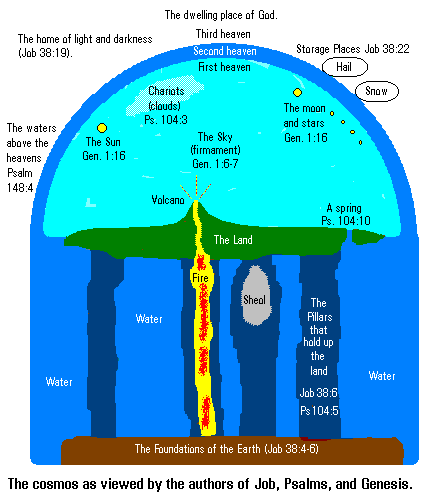LESSON 2
Genesis for Today: Chapter 1
by Herb Drake
This work may be freely reproduced and distributed provided that no changes are made, no revenues are collected beyond the nominal cost of media, and credit is given to the author and House Church Central. Any other use requires the written permission of the author. Citing this material on other Internet sites is encouraged but is to be done only by providing a hypertext reference to this file on this server.
The Bible's first chapter is among its most misunderstood, both by those who ridicule it as inconsistent with modern science and by those who defend it as if it were science. The root of the problem may be traced to the "Age of Enligtenment" (c. the 1700s), when the church took a tragic wrong turn. As scientific discoveries demonstrated that God's word was being misunderstood, the church dug in its heels and persisted to insist that Genesis 1 was science. That approach, still taken by many Christians today, had tragic consequences. First, it caused many thinking people to reject the Bible because they reasoned that if the Bible had poor science it could not be relied upon for anything else; secondly, it caused the real teachings of Genesis 1 to be lost in that pointless controversy.

The subject of Genesis 1 is, of course, the cosmos. It is a subject that the biblical writers regarded as important--but not because the people of the wilderness experience needed a science lesson. It was important because the people needed some foundational knowledge to provide a background for their faith and daily behavior.
The Ancient Worldview
Any study of Genesis 1 must begin with a look at the way the ancient people understood the cosmos. Fortunately, one may do this from sources within the Bible itself. The book of Job and some of the "creation" psalms are particularly revealing. We see that the ancients understood the cosmos exactly as we would expect a pre-scientific culture to do so. They regarded pre-creation cosmos to be water, often regarded as "chaos" because the waters of the storm or of the sea were often turbulent, frequently claiming ships and their cargo.
- One could venture to the sea shore and see water as far as the eye could see.
- If one dug a hole, there would be water there (ancient Israel was greatly dependent upon wells for feeding its livestock).
- And, of course, who could fail to notice the water coming from the sky during a rainstorm?
So the ancients viewed the land and the sky as a protected space that God had made, and it was God who "shut up the sea ... [and] said 'This far you may come and no farther.'" (Job 38:8-11). The flood judgment of Gen. 6-8 was seen as a relaxing of that protection, the waters coming from above, below, and from the abyss; it was a symbolic act of "uncreation."
The Figure shows the pre-scientific cosmos in greater detail. The land was held above the waters by "pillars," and within the pillars were Sheol and fire. The dome of the heavens, held in place by mountains (pillars, again) was made of water, and the sun, stars, and moon were moved around its surface by God. The "firmament," or sky, was a great air bubble that God had formed when he separated the waters.
Why is this important? Simply because the proper way to appropriate any biblical text is to first understand something about the culture to which the account was written. To approach Genesis 1 from the standpoint of modern cosmology is highly abusive to the text; the real lessons of Genesis come to us only when we approach it the way the ancients understood it. And what are those lessons? They are evident as one reads the account.
Creation from Nothing and its Implications
First, God created "from nothing." He did not use his own substance, so pantheism is denied. Secondly, God created astronomical objects as mere "messengers," thus asserting that heavenly bodies (Gen. 1:14) are not worthy of worship. Likewise, the trees and rocks are creations of God, not gods themselves (Gen. 1:11--it is the "land" that produces vegetation). Again and again we see "God created," making it clear that the Creation is not itself worthy of worship, but rather that it points its creator, who alone is worthy of worship. Also, the creation was deemed to be "good," so the gnostic idea that matter is evil is denied.
As eastern religions continue to penetrate our society, the lessons of Gen. 1 need to be heard and understood by the people of God. Baal may not be popular anymore, but the polemics of Genesis work just as well against Buddhism and Hinduism as they did against Baal. Christians who fail to correctly understand Genesis 1 are vulnerable to such false teachings. To appropriate these important lessons we need to appreciate the fact that God met his people at their own level of understanding, just as he meets us today.
In God's Image? or As God's Image?
When the account gets to the creation of humanity (1:26), our bible's say that humanity was created in God's image. But the Hebrew can also be translated "as God's image." Here are some of the options:
- IN God's image: The ability of humans to have relationship with God, something that animals cannot have.
- AS God's Image: The ability and obligation of humans to act as agents of God. M. S. Heiser translates the word as "imager."
The "image" idea also implies that there is a ranking in the creation, man being above the trees and animals (see especially 1:28). The ancient peoples of the wilderness needed these lessons, as they provided a basis for resisting the lure of the religions of their neighbors.
| Introduction | Genesis 2 |

